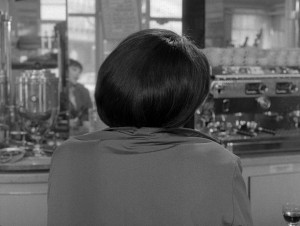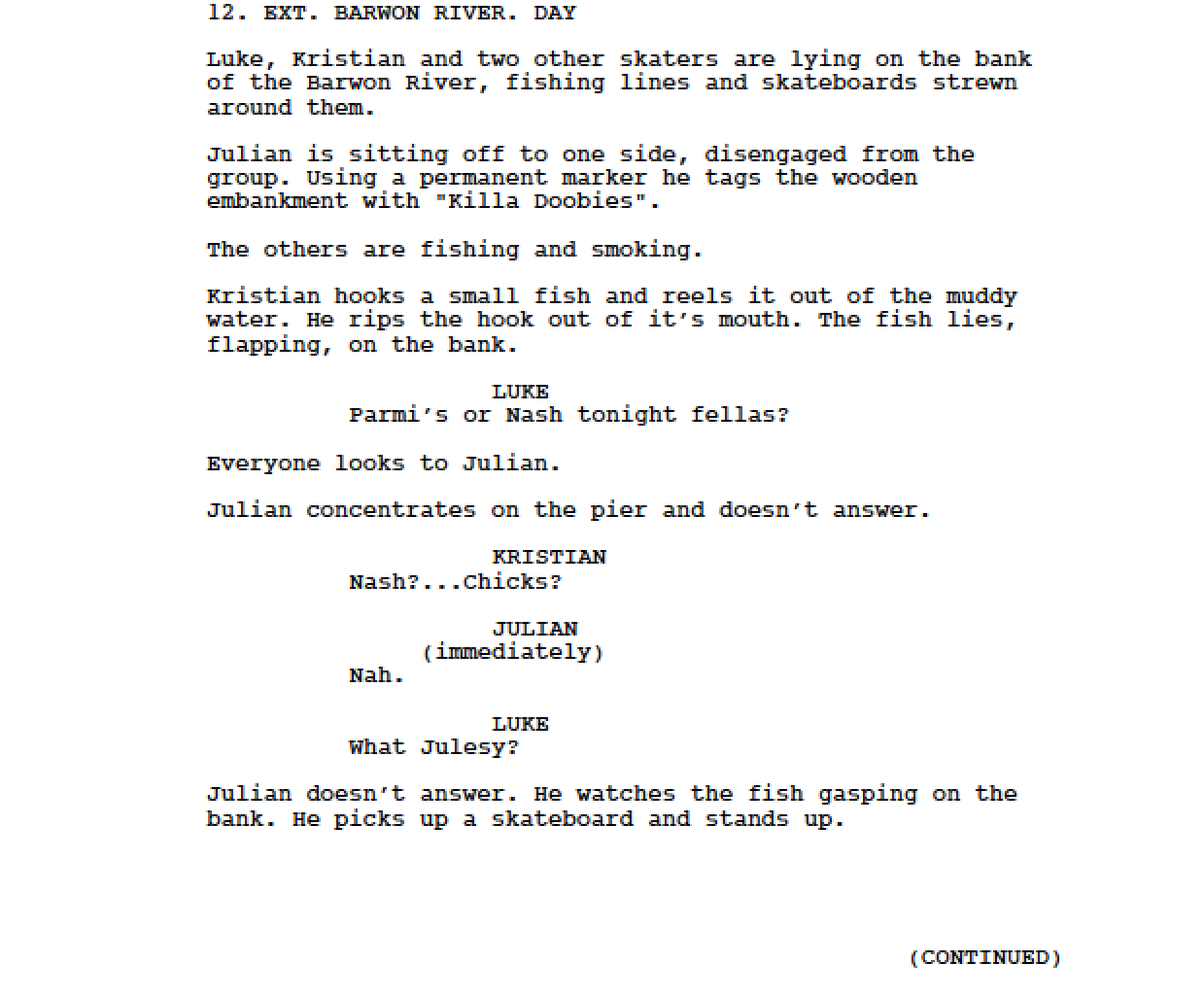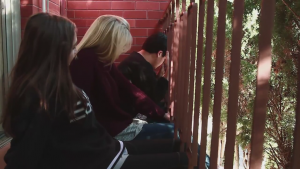The edit:
The script (by Ineke Adamson):
The scene I made based on Akira Kurosawa’s method of filmmaking was mainly an investigation into ‘multicam’ shooting. Thus, I was not worried about the audio quality, the narrative or the ‘definition’ of the visuals. For the shoot I used two different DSLR cameras (a Canon 7D and a Canon 650D) and this is why the two perspectives I shot from appear dissimilar in terms of colour and quality on screen. Nevertheless, it didn’t really matter because I just wanted to get an idea of what planning, shooting and editing a multicam sequence might be like.
Before the shoot, I drew up a storyboard and a floor plan which mapped out where the characters and the cameras were going to be positioned.
I then tested these ideas by looking through the cameras in the actual location, to make sure I could construct the compositions I wanted, without one camera being able to see the other. I used two lenses that had a substantial zoom, so that I could position the cameras as far away from the actors as possible. This was because I wanted to test Kurosawa’s claim that actors feel more comfortable and thus perform more realistically when they don’t have a camera in their face or know which perspective is going to be used in the final edit. However, the balcony where I was shooting was not spacious and so the cameras ended up being only a metre or so away from the actors. Ultimately this investigation would have worked better in a larger space, but I still think that having the camera that little bit further away was less daunting for the actors.
I think that the multicam idea as a whole makes actors feel more comfortable, and this is not just because the cameras are further away from them than usual. Although I really shouldn’t have acted in my own scene (I should have been behind at least one of the cameras), it was a useful exercise in terms of seeing how I felt as a performer in this situation. Overall I thought it was great, because usually on shoots where the filmmaker is practically editing in camera, you don’t feel like you can move around so much, because you have to be cautious of continuity issues. However, when you get to do the whole scene in one go, you can let the dialogue flow a bit more, you can react to the other actors more naturally and really get into the scene, without having a director stopping you to change camera positions or do another take of the same shot. I was also able to play with my hair, move my head from side to side and lean on my hands at various points in the scene spontaneously, because I knew that the graphic continuity of the scene was not going to be an issue during the editing process.
For me, this was probably the most interesting investigation so far because it defied all of my expectations. Originally I had thought that because I was using a script (rather than a prose) and had already planned out my framing, there would be no room for improvisation during the actual shooting process. I thought that because we had to strictly ‘abide’ by the script and construct the timing in real and reel time there wouldn’t be much room for creativity. However, this idea of time is really where the spontaneity and creativity came in. Although we had specific lines we had to say and we were positioned in particular places, we (the actors) had the freedom to decide how we would deliver the lines, what hand gestures we used, how we utilised our body language and most importantly, how we would ‘time’ the scene. Although these ‘elements’ of acting have also been quite improvised in my previous shoots, it is this idea of ‘real time’ that generally becomes superfluous on set because it is altered in post production. I think it would be interesting to do a similar investigation using multiple cameras as well as using a prose instead of a script. This would really open up the opportunity for the actors to improvise. (This exercise will only eventuate if I feel like I want to keep going down the multi cam path and discontinue my exploration of other shooting methods).
Even though this freedom for the actors was great using this method, I don’t think it was of much benefit for the filmmaker. There was much less room for creativity during the editing process, which surprised me, because I thought this method of shooting would cause me to make most of the decisions about the scene in post production. Although I got to decide on the pacing of the scene and which perspective would be shown at particular moments, the editing process was rather limited. It was practically like trying to edit a single shot/take because there weren’t really any ways for me to elongate or shorten time; I was essentially just stuck with the scene as it had been performed on the day.
Overall I thought some parts of the scene worked out well, but there were other things that I wasn’t happy with. Originally I thought it would look visually appealing to film the back of the characters heads; as Jean-Luc Godard did in Vivre Sa Vie (1962, France).

Anna Karina pictured above in Godard’s Vivre Sa Vie.

However, I don’t think the shot really worked aside from the fact that it highlights the disappearance of each character as they leave the frame. I actually think this scene would have worked better if it had have just been a long single shot from the side profile (pictured below); but, for the purpose of this investigation I edited both perspectives together.
I think this angle (above) works well, because the framing is quite dynamic with each character on a different plane (I should have had a deeper depth of field though, so that each character was in focus). The bold red-brick background and the trees on the right side of the composition create an interesting setting and also contrast against the actors’ skin tones. I think another camera angle from the opposite side of the characters or from below would have added to the scene, because we don’t see much of their faces from either of the positions I shot from. However, this shoot was difficult because I had a limited number of crew members, a constrained location and I couldn’t really have any camera movement or place another camera on the opposing side of the actors because otherwise the audience would be able to see the camera equipment in the frame.
One of the advantages of editing multi cam sequences is that you get an unbeatable sense of continuity and flow. The cuts are as seamless and as unnoticeable as you’re ever going to get them. One of the main issues while editing a shoot that has been shot with one camera from several perspectives is the idea of continuity. It is practically impossible to create a perfectly continuous cut, because there is often a discontinuity in a character’s movement or appearance. This is why I think this shooting method would be greatly beneficial for action sequences or any type of scene where there is a lot of movement. In reality, I don’t think the scene I shot really demanded a multicam setup (it probably could have been as easily edited with the use of just one camera). All in all, I believe that the use of multiple cameras only really needs to be used when the continuity of a sequence is absolutely vital.
In conclusion, I found that the multi cam setup was beneficial for the actors’ performances, but was limiting for the filmmaker in terms of camera positions and editing.




